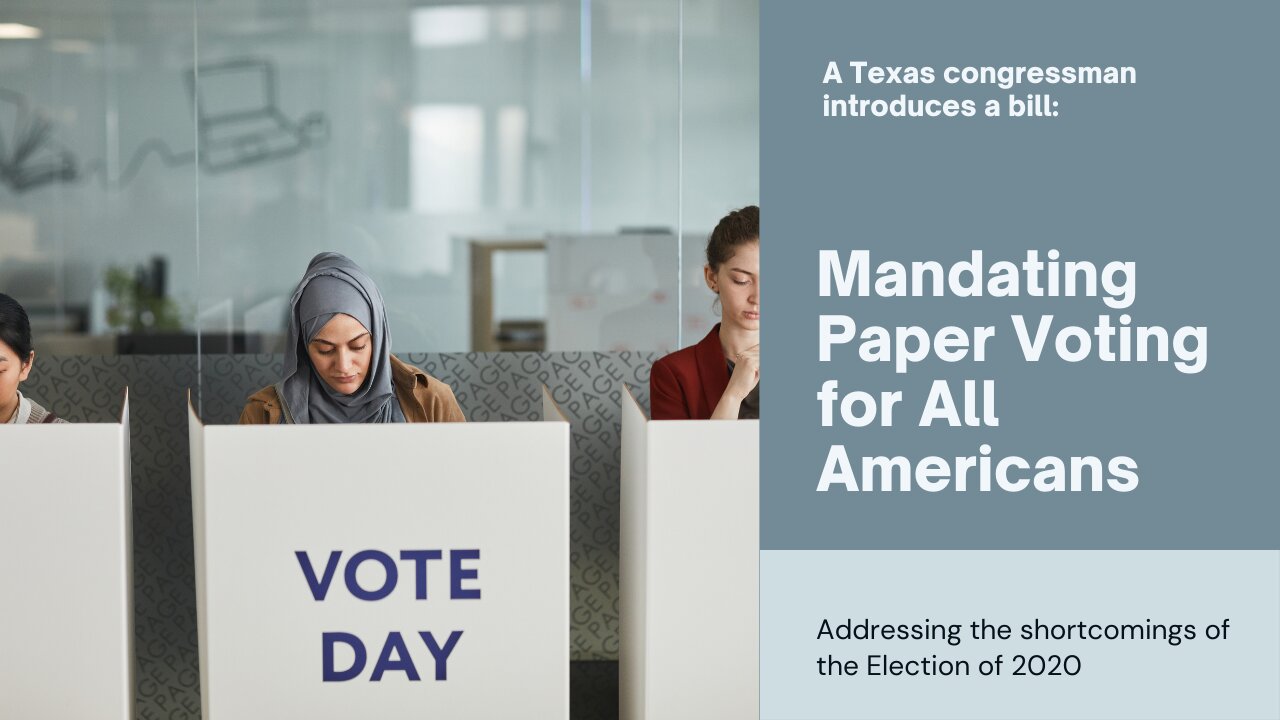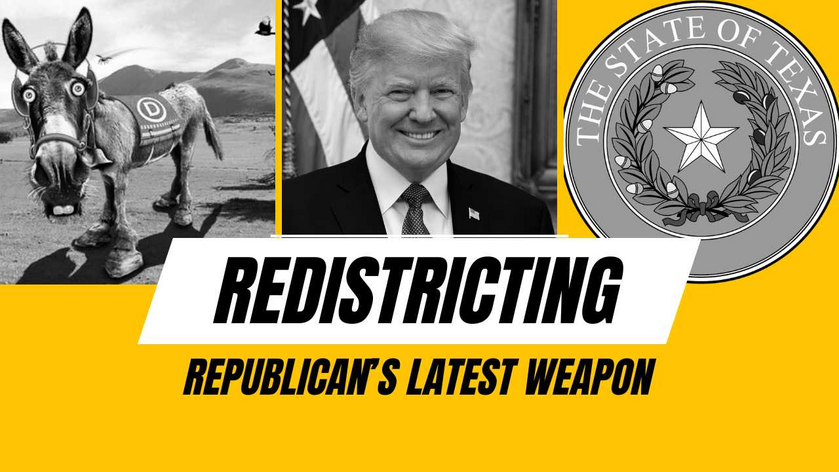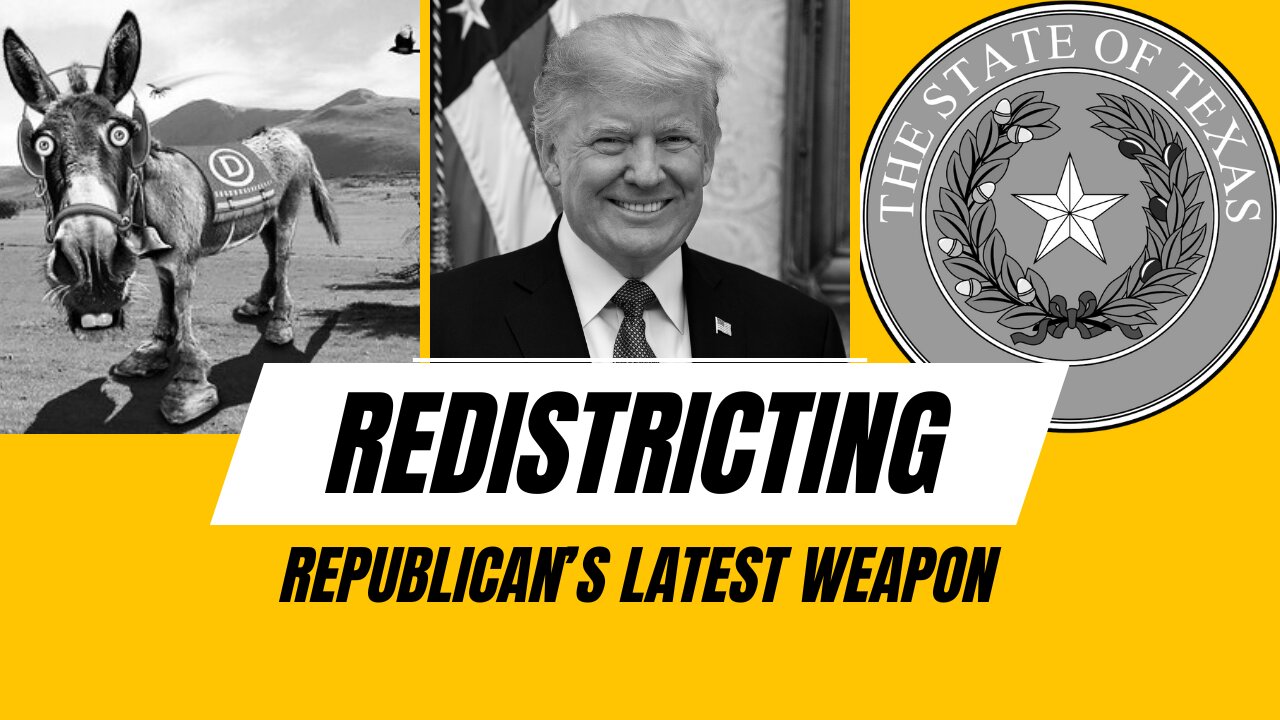The first-ever bill to require an all-paper voting system with manual counts at the precinct is already taking shape. This bill would eliminate every kind of machine, including even the electronic poll book. CNAV has reviewed a draft copy that The Gateway Pundit obtained, either from its author or from the Congressional office that helps with bill drafting. The philosophy of this bill is brutally simple: paper ballots, paper poll books, paper everything – and limited absentee voting. Passing this bill will be very difficult – but the wrong kind of refinements would defeat its purpose.
Qualifications to evaluate this proposed paper system
Your editor has been an Officer of Election (OOE) since at least 2002, and has served in Essex County, New Jersey, and Henrico and Hanover Counties in Virginia. In fact, your editor is now a Chief OOE in Hanover County, and has run three elections as Chief. These included the non-Presidential federal primary and general elections of 2024, and a special State Senator’s election this year.
In that time your editor has trained on and worked with paper and electronic pollbooks, and the old Print-O-Matic® machines. More recently he has used the ExpressVote® Ballot Marking Device (BMD) and DS-200 scanner-tabulator by Election Systems and Software. (ES&S do not sponsor this site.)
Your editor never saw an election as “messy” as those in Atlanta, Georgia in 2020 or Phoenix, Arizona in 2022. But he is familiar with dead or moved-out voters who still receive sample ballots at their last addresses of record. So the votes of the dead and the move-outs do present a serious problem – because no one knows how many there are. In fact, the relaxed rules for mail-in absentee voting were the decisive “cheat methods” for the Election of 2020.
Your editor’s jurisdiction restricts the BMD to disabled voters only. As Chief, he has managed thus far to avoid having a voter use it, by collecting written Requests for Assistance from voters, and their own designated assistants, who have reported to the precinct. Precincts in our county typically have between 2000 and 3500 registered voters each.
Who is Pete Sessions?
Rep. Pete Sessions (R-Texas-17th) has been in the House of Representatives since 1997, except for a two-year enforced hiatus (2019-2021). He sits on the Finance and Oversight and Government Reform Committees. Sessions voted for Donald Trump’s positions 97.5 percent of the time.
More to the point, he became a staunch advocate for increased election security after returning to Congress in 2021. He had successfully won in a (for him) new District on November 3, 2020 – the election Trump lost. Sessions signed a favoring friend-of-the-court brief in Texas v. Pennsylvania. In short, the Election of 2020 – the Big Steal – affected him greatly. He wants to prevent a recurrence, and has identified every influences that could have played any role in it.
His legislative record is not promising. He has seen one bill to enactment, besides two purely symbolic acts. The GSA Technology Accountability Act requires annual reports on two GSA funds having to do with information technology services. Sessions had the cosponsorship of Rep. Gerry Connolly (D-Va.), Ranking Member at House Oversight. President Joe Biden signed this into law on December 23, 2024.
Two proposed all paper systems
Rep. Sessions has written the Make Elections Secure Again (MESA) Act. The Gateway Pundit obtained a draft copy of his proposed Act. On the other hand, CNAV has reviewed extensively the best all-paper system currently in use, in France.
Rep. Sessions’ bill applies, at minimum, to federal elections – for Presidential Electors, Senators, and Representatives. Sessions relies on the Constitution for federal authority to regulate such elections.
Article I Section 4 reads in relevant part:
The times, places and manner of holding elections for Senators and Representatives, shall be prescribed in each State by the Legislature thereof; but the Congress may at any time by Law make or alter such Regulations, except as to the Places of choosing Senators.
That last is a holdover from the time that State legislators chose Senators directly.
Article II Section 1 reads in relevant part:
Each State shall appoint, in such Manner as the Legislature thereof may direct, a Number of Electors, equal to the whole Number of Senators and Representatives to which the State may be entitled in the Congress.
In the French system, voters pick up pre-printed slips of paper, or bulletins, each listing one race and one candidate (or oui or non on a public question). In the privacy of the voting booth, they seal their bulletins in an envelope. Then they come out and identify themselves to the OOE. Once that officer is satisfied, he accepts the envelope and drops it into the ballot box. After polls close, OOEs open the envelopes and count the ballots. Out of sheer practicality, no OOE has to handle a sheet of paper more than once.
Mail-in ballots are not allowed. Instead, any voter knowing he will not be able to vote in person on Election Day, pre-registers a proxy. Pre-registration occurs at the local police precinct (commissariat de police) or courthouse. Or a court can send someone to a bedridden voter’s home. A voter may “carry” one proxy only.
The Sessions System
Pete Sessions has never, to CNAV’s knowledge, studied the French system. His system works as follows:
No precinct will have more than 1500 registered voters. (Your editor’s jurisdiction would likely have to create perhaps 75 percent more precincts to comply with this rule.)
Registration would have a deadline of thirty days in advance of any election in which one wishes to vote. Same-day registration would cease. Anyone registering to vote from the date of enactment must show proof of United States citizenship. Birth certificates or passports will serve. (More likely, the voter must offer the same proof of citizenship that Form I-9, the Work Eligibility form, requires.) State Elections Divisions will “vet” existing registered voters at voter registration, driver’s license, or passport renewal time.
Registrars will acquire ballot stock from federally certified vendors. These stocks will carry watermarks or other security measures to attest to their authenticity. Registrars will print all ballots ahead of time – never at the polling place.
Precincts will be open on Election Day or not more than three days in advance. Presumably this would cover OOEs assigned to work precincts not their own.
Mail-in ballots would be available only to:
Active-duty military service members who submit their orders to a station outside their precinct, or:
Voters who show, with a doctor’s note, that their health prevents their voting in person.
How the actual election takes place
Voters will report to the precinct and sort themselves into the A-Hs and the I-Zs, or divide at some other letter of the alphabet. Voters in each line will report to one of two OOEs, each guarding a paper pollbook. The voter shows a government-issue photographic identity card, like a driver’s license or a passport.
The voter will sign the pollbook at check-in. That signature block will constitute an affidavit that the voter:
Is a United States citizen,
Will not vote elsewhere, and
Has not voted in the current election before presenting themselves at the precinct.
One who swears falsely by so signing, shall be guilty of a felony, subject to fine, imprisonment, or both!
OOEs will issue paper ballots after receiving the signature. The precinct will offer a BMD available only to a handicapped voter. The Chief will also offer a written request-for-assistance form to voters who bring in trusted assistants. The BMD must produce a human-readable ballot.
After polls close, the OOEs, who have received training in ballot counting, will count the ballots. Session’s bill does appear to allow a registrar to train counting officers. Pairs of OOEs, ideally one member from each Party, will count all ballots. They are to tally the counts for all races on “standardized forms” that all counters must sign. All this will take place in full view of Party-accredited challengers and the public. The Chief has four hours after polls close to call his precinct’s results in.
A few more details
The actual vote count would take place live, on Internet stream. Unit (county/parish/independent city) circuit courts must preserve all such recordings for five years.
States shall upload to a public website, within five days of close of polls:
Precinct-by-precinct results from the hand count,
Numbers and percentage turnout of registered voters,
“Ballot images and cast-vote records from any secondary tabulators, unscrambled and in original order” [an obvious intent to make “falling back on a machine” a very expensive proposition], and
Records of the chain of custody of ballots.
State Election Divisions shall offer human- and machine-readable versions of these files. “Secondary tabulators” bear very little mention, and authority for their use remains unclear.
Finally, the MESA Act establishes a Technical Review for United States Security and Technology, or TRUST, Board. This Board would exist within the National Institute of Standards and Technology (NIST) – the federal weights-and-measures office. Per the Appointments Clause, this bill vests appointment of the TRUST Board in the NIST Director. It shall consist of five members, chosen for expertise in election integrity, and appointed to “six-year staggered terms.”
This Board shall certify, among other things:
Vendors of paper ballot stock,
Ballot Marking Devices and any back-up Electronic Pollbook Systems or (where authorized) secondary tabulators,
File formats for publicly available election data, and
Compliance with the new law by State Election Divisions.
The virtues of a paper system for voter check-in and vote casting
As CNAV pointed out nearly twenty-one months ago, voters originally voted on paper. In France, they do again, and have since 1975.
The firm registration deadline lets registrars print paper pollbooks far enough in advance for Chief OOEs to pick them up. But because early voting must use the same paper pollbooks as on Election Day itself, Chiefs will have two choices:
Drive into the election office late in the evening before to take possession of the pollbooks, or:
Open the polling places at least half an hour earlier on Election Day. Then the unit police or sheriff’s office, or the Grounds Force, can bring the pollbooks to them.
Today many unit registrars entrust their Chiefs with backup paper pollbooks and other records, to keep overnight. But this new TRUST Board will have to certify procedures for bonding a Chief. That will make him legally responsible for the security of all records and supplies of which he takes possession.
Paper check-in introduces a new element of responsibility and accountability for voters. Signing a pollbook now entails swearing, under penalty of perjury, to:
The voter’s identify and citizenship status, and
His intent to cast an honest ballot – only once.
Perhaps that’s worth having the Chief divide waiting-in-line voters into the A-Hs and the I-Zs.
The absentee and college votes
Rep. Sessions does not believe any voter can or should be a proxy for another. But today voters may bring in assistants they trust. From assistant to proxy is a small step, especially if the proxy must pre-register with police, sheriff’s office, or court. The French limit a voter to being a proxy for one other voter only. Even so, mail-in ballots for active-duty military stationed out-of-precinct remains necessary, because not all active-duty military have “significant others.” (Of course, the United States could declare that, as long as you’re in uniform, you don’t have a vote. But that could only be part of a reform like restricting the vote to veterans. See Starship Troopers by Robert A. Heinlein for a thorough description.)
One issue Rep. Sessions must consider is the “college vote.” Today college students vote in precincts in the city of their campuses. Under Sessions’ paper system with very limited early voting, college students would do the same. This unfairly skews the vote in any college town leftward. Parents of college students should pre-register as proxies for their children they’re supporting through college. The alternative: colleges declare a short class week and send students to fly home, vote, and fly back. (Or else we repeal Amendment XXVI and re-raise the age of adult majority to twenty-one.)
How quickly can we count paper ballots?
Sessions also retains the Australian Ballot that, in 1888, replaced pre-printed Party “tickets.” Counting such a paper ballot effectively, requires:
Handling each ballot as often as all the races and public questions in the election, or:
Tallying each vote on a paper ballot on a form that calls for the recording of tally marks.
That’s half the reason to pair off and count ballots, in addition to using one OOE from each Party. The pair divides a batch of ballots between them, like a playing-card dealer cutting a deck. Each pair mate counts half the stack, and then the pair mates switch stacks to count the other half. When the two members of the pair finish counting, and arrive at the same results, then and only then do they report their results to the Chief.
Rep. Sessions would give an OOE team four hours (typically, 8:00 p.m. to midnight) to count all votes. That must allow for a pair having a discrepancy in results – and having to start all over again. (That’s also why Rep. Sessions limits precinct sizes to 1500 registered voters.)
The TRUST Board would necessarily certify the training of vote counters – and OOEs performing voter check-in, and of Chiefs. Recent polls show that units adopting paper systems would have no shortage of volunteers to count votes after polls close. Whether they could all train adequately to count up to 1500 votes – in full view of a webcam, at that – is another matter.
Cue the lawsuits
Without a doubt, passage of this MESA Act will trigger lawsuits. The League of Women Voters and other “voting rights advocacy” groups will cry “Vote suppression!” Registration deadlines and rigid photo ID requirements will give them standing.
Dominion Voting Systems would lose all its American markets. Its BMD produces a Quick-Read code no human (except perhaps a brilliant autistic savant) could possibly read. Election Systems and Software would still have a market for their ExpressVote® BMD. Its output is human-readable. (However, aggressive education on Requests for Voter Assistance could destroy that market, too.) But their DS-200 scanner-tabulator would find no more market. So expect them to sue – though even Institutionalists Roberts CJ and Barrett and Kavanaugh JJ might deny them standing.
Perhaps Rep. Sessions wanted to avoid – or never considered – reforming the “college vote.” Imagine the lawsuits from college-student groups hoping to keep the “college vote” concentrated. But standing might be even more difficult to establish – and the airlines would love such a reform. (Imagine how many round-trip tickets they’d sell.)
Happily, Rep. Sessions made his law severable. If the thirty-day registration deadline falls, the paper ballot and check-in system most probably would not. But the most important reform in the MESA Act is elimination of widespread mail-in voting. Expect California, Colorado and Oregon to sue over that – because their governments know that, without mail-in balloting, their States become battlegrounds.
Conclusion
The MESA Act mandates a paper elections system – paper ballots and check-in – that holds up well against its French counterpart. Both systems share a monumental disdain for mail-in absentee balloting. The French forbid it absolutely; Rep. Sessions would retain it for active-duty military and the bedridden. This last reflects Sessions’ disdain for – or lack of knowledge of – the notion that any citizen could carry another’s proxy.
CNAV still prefers to issue one ballot for each race or public question. Such ballots would be easier to count without error. But French-style bulletins, that each name one candidate, would not be suitable. Imagine a Chief OOE finding that he’s handing out a lot of bulletins for one candidate. He would thus know who was winning, and that knowledge could cloud his judgment. Better to issue ballots a voter must mark in private. Better still to preserve the write-in capability, a thing France does not allow.
The MESA Act is a promising start. But to have any hope of success, it needs much wider legislative support. Rep. James Comer (R-Ky.), Chairman of House Oversight, needs to study this bill. Sen. Ted Cruz (R-Texas) should be introducing a companion bill in the Senate. Other Senators and Representatives should be supporting this, too.
All this requires strong popular support. Rasmussen recently reported results indicating that the American people want just such reform as this. And aside from minor adjustments, no one has any legitimate cause to oppose it.
Link to:
The article:
https://cnav.news/2025/03/08/foundation/constitution/paper-ballot-first-federal-bill/
Video:

The Make Elections Secure Again Act:
Descriptive article:
https://www.thegatewaypundit.com/2025/03/rep-pete-sessions-introduce-make-elections-secure-act/
Draft copy:
https://www.thegatewaypundit.com/wp-content/plugins/pdfjs-viewer-shortcode/pdfjs/web/viewer.php?file=https://www.thegatewaypundit.com/wp-content/uploads/2025/03/mesa-bill-make-elections-secure-act.pdf&attachment_id=1333946&dButton=true&pButton=true&oButton=false&sButton=true&pagemode=none&_wpnonce=5003d45071
Starship Troopers (for a description of a society in which only veterans of military or other life-threatening service may vote):
https://cnav.news/2018/06/23/editorial/classics/citizenship-best-test/
Declarations of Truth:
Declarations of Truth Locals Community:
https://declarationsoftruth.locals.com/
Conservative News and Views:
Clixnet Media





















